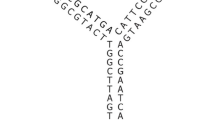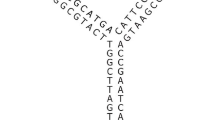Abstract
Given a set of flexible branched junction DNA molecules with sticky-ends (building blocks), called here “tiles”, we consider the problem of determining the proper stoichiometry such that all sticky-ends could end up connected. In general, the stoichiometry is not uniform, and the goal is to determine the proper proportion (spectrum) of each type of molecule within a test tube to allow for complete assembly. According to possible components that assemble in complete complexes we partition multisets of tiles, called here “pots”, into classes: unsatisfiable, weakly satisfiable, satisfiable and strongly satisfiable. This classification is characterized through the spectrum of the pot, and it can be computed in PTIME using the standard Gauss-Jordan elimination method. We also give a geometric description of the spectrum as a convex hull within the unit cube.







Similar content being viewed by others
Explore related subjects
Discover the latest articles, news and stories from top researchers in related subjects.Notes
Other than assuming uniform mixing, the thermodynamic properties of the molecules in the test tube (pot) are not included in the description of the assembly process. Also, a relatively uniform melting temperature for all sticky-ends is assumed.
References
Adleman LM, Kari J, Kari L, Reishus D (2002a) On the decidability of self-assembly of infinite ribons. Proceedings of FOCS 2002, IEEE symposium on foundations of computer science, Washington, pp 530–537
Adleman LM, Cheng Q, Goel A, Huang M-D, Kempe D, Moisset de Espanes P, Rothemund PWK (2002b) Combinatorial optimization problems in self-assembly. Proceedings of the thirty-fourth annual ACM symposium on theory of computing, pp 23–32
Brondsted A (1983) An introduction to convex polytopes. Springer-Verlag, New York
Chen JH, Seeman NC (1991) Synthesis from DNA of a molecule with the connectivity of a cube. Nature 350:631–633
Cooper L, Steinberg D (1974) Methods and applications of linear programming. W. B. Saunders Company, London
Goodman RP, Schaap IAT, Tardin CF, Erben CM, Berry RM, Schmidt CF, Turberfield AJ (2005) Rapid chiral assembly of rigid DNA building blocks for molecular nanofabrication. Science 310:1661–1665
Jonoska N, McColm GL (2005) A computational model for self-assembling flexible titles. In: Calude CS et al (eds) LNCS, vol 3699. Springer-Verlag, Berlin, pp 142–156
Jonoska N, McColm GL (2009) Complexity classes for self-assembling flexible tiles. Theor Comput Sci 410(4–5):332–346
Jonoska N, Karl S, Saito M (1999) Three dimensional DNA structures in computing. BioSystems 52:143–153
Jonoska N, Sa-Ardyen P, Seeman NC (2003) Computation by self-assembly of DNA graphs. Genet Program Evolvable Mach 4:123–137
Jonoska N, McColm G, Staninska A (2006) Expectation and variance of self-assembled graph structures. In: Carbone A, Pierce N (eds) LNCS, vol 3892. Springer, Berlin, pp 144–157
Kao M-Y, Ramachandran V (2001) DNA self-assembly for constructing 3D boxes. Algorithms and computations, ISAC 2001 proceedings, LNCS, vol 2223. Springer, Berlin, pp 429–440
Kurtz SA, Mahaney SR, Royer JS, Simon J (1997) Active transport in biological computing. In: Landweber L, Baum E (eds) DIMACS, vol 44. American Mathematical Society, RI, pp 171–181
Mao C, Sun W, Seeman NC (1999) Designed two-dimensional DNA holliday junction arrays visualized by atomic force microscopy. J Am Chem Soc 121(23):5437–5443
Panik MJ (1996) Linear programming: mathematics, theory and algorithms. Kluwer Academic Publishers, Dordrecht
Qi J, Li X, Yang X, Seeman NC (1996) Ligation of triangles built from bulged 3-arm DNA branched junctions. J Am Chem Soc 120:6121–6130
Reif JH, Sahu S, Yin P (2006) A self-assembly model of time-dependent glue strength. In: Carbone A, Pierce N (eds) LNCS, vol 3892. Springer, Berlin, pp 290–304
Rothemund PWK, Winfree E (2001) The program-size complexity of self-assembled squares. Proceedings of 33rd ACM meeting STOC 2001, Portland, OR, May 21–23, pp 459–468
Rothemund PWK, Papadakis P, Winfree E (2004) Algorithmic self-assembly of DNA Sierpinski triangles. PLoS Biol 2(12):e424
Sa-Ardyen P, Jonoska N, Seeman NC (2004) Self-assembly of graphs represented by DNA helix axis topology. J Am Chem Soc 126(21):6648–6657
Seeman NC, Chen JH, Kallenbach NR (1989) Gel electrophoretic analysis of DNA branched junctions. Electrophoresis 10:345–354
Shih WM, Quispe JD, Joyce GF (2004) A 1.7-kilobase single stranded DNA folds into a nanoscale octahedron. Nature 427:618–621
Staninska A (2007) A theoretical model for self-assembly of flexible tiles Ph.D. Thesis, University of South Florida, Tampa
Winfree E (1998) Algorithmic self-assembly of DNA, PhD Thesis, Caltech, June
Wu G, Jonoska N, Seeman NC (2009) Construction of a DNA nano-object directly demonstrates computation. BioSystems 98(2):80–84
Zhang Y, Seeman NC (1994) The construction of a DNA truncated octahedron. J Am Chem Soc 116(5):1661–1669
Acknowledgments
Authors would like to thank Stephen W. Suen, David A. Rabson, and the referees for providing valuable suggestions. The work is supported in part by NSF grants CCF #0726396 and CCF #0523928.
Author information
Authors and Affiliations
Corresponding author
Rights and permissions
About this article
Cite this article
Jonoska, N., McColm, G.L. & Staninska, A. On stoichiometry for the assembly of flexible tile DNA complexes. Nat Comput 10, 1121–1141 (2011). https://doi.org/10.1007/s11047-009-9169-1
Published:
Issue Date:
DOI: https://doi.org/10.1007/s11047-009-9169-1




